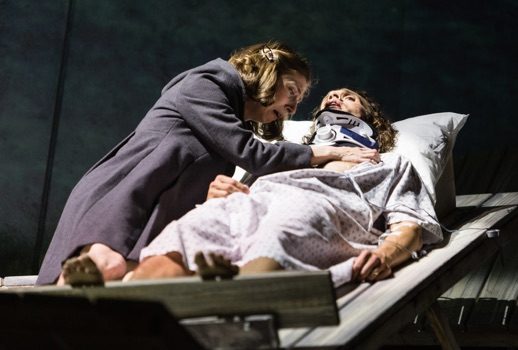

The “industry audience” that was present of course expected to cheer the composer, a popular figure in New York’s new music circles. But the stunned silence when the curtain fell is not something that can be planned. Neither did the screaming ovation that followed sound like pro forma good will.
Mazzoli found a way to dramatize in music the paradoxical falling/rising of a simple girl, Bess, who from the utmost degradation and a terrible death becomes a healing spirit of love affirmed against the odds, expressing a pure impurity. The story is set on the Isle of Skye, seaside, in the 1970’s. Bess—because of her love for her husband—defies conventional lower middle class morality, a venomously repressive life-denying Christian religion to become as one with the eternal feminine, a transcendent spirit of courageous joy and affirmation. Mazzoli used a fairly simple technique, falling and rising slides which sometimes become scales that ascend and descend, to make us continually aware of the fall/rise of this great spirit.
Mazzoli proved that originality in music is not something literally never heard before but rather a combination of familiar techniques, some from the musical avant-garde of sixty years ago (what was then called musique concrete), some rooted in “serious” Western Music, some generated in the 1980’s (Minimalism). She wove them into an unexpected and rich tapestry, not heard before, not in this way and not to this effect.
Vavrek’s handling of the story, based on Lars Von Trier’s disturbing 1996 film, evoked the operatic trope of woman as redemptive force, becoming a very contemporary version of Wagner’s “The Redemption of the World through Love” idea at the end of the Ring or his Senta (like Bess a redeemer by the sea) to a Lulu-like earth spirit who embodies the shocking and disturbing sexual power of women. But unlike that unfortunate, Bess transcends what society regards as a perversion to create in death a kind of miracle.
Mazzoli is herself a performer. She began in music as an adolescent singer. She has an all-female “post-rock” band called Victoire, indeed in Breaking the Waves she uses an electric guitar as the voice of God; it had, she said “ambiguity and strangeness”. Singing was her first musical impulse in life, later refined by formidable training, and extensive experience writing “serious music.” It makes her a natural for opera. That she has a spontaneous love of music rooted in word, emotion, theater, supported by complex structures and high sophistication and a constant contact with the emotional states of characters allows her to create drama through music.
In contrast to most academically trained composers, Mazzoli understands that performers are the lifeblood of opera. They must serve but also be served by the music. With tremendous skill, Mazzoli has made the role of her heroine, Bess, an equal of the great virtuoso roles in opera.
And she found an astounding singer: Kiera Duffy, who gave one of the greatest performances I have seen in the opera house in the past 20 years, maybe more. Duffy rolled back time to become what great opera singers are supposed to be but usually aren’t now—an unforgettable embodiment of profound emotion through music. I doubt the audience at this world premiere understood that Duffy was giving an archetypal performance of tremendous authority, accomplishment, and profundity in something new. She was the great singer as both creator and servant without whom an opera can’t work.

Duffy has a sweet crystalline high soprano. She is at ease over a very wide range. She was always precisely in tune and every word was clear even very high— in a Scottish accent no less! She is a superb musician, shaping phrases, allowing her voice to find the musical impulse at every second. She is also improbably brave for an operatic performer. She sang naked, was bare breasted often, and gave herself over to the sexual behavior of the character without even an instant of self-consciousness. What she did is very risky for a performer and she worked without a net, throwing herself into Bess and personifying this entire work.
Breaking the Waves, like many recent operas uses a film as its basis, not the easiest task of adaptation. Most of the operas of the past were based on plays where the narrative—however much it had to be simplified and changed to accommodate music—had already been solved for the stage. But in a film, an entire universe can be delivered directly to the viewer’s brain, encompassing events impossible to depict in a live theater.
Neither the horrifying accident that nearly kills Bess’s Norwegian husband, Jan nor her detailed sexual exploits with him and then a range of men at his request can even begin to be recreated on stage. The complex rig in the strange light of the island, the sound of waves, the dreary streets and the lives of the shadowy people who walk them can barely be hinted at on stage.
Vavrek had to find a way to tell this story on a modest sized stage in a low- budget context where much of what happens and all the locations could only be suggested in simple ways. He needed to find text that established characters directly and simply but did not reduce them to cartoons. He had to dramatize with the most simple tools—words and stage actions—without signposting or “indicating” highly specific and often strange events. He accomplished this task admirably. There was nothing silly, inapt, over-general in what he wrote. His words are well chosen for music and sound natural when sung.
The thrust of the story was maintained and never trivialized. Bess, a girl with a history of psychiatric problems (she “takes pills” for her difficulties), falls ecstatically in love with a Norwegian rig worker named Jan. She is drawn to him by the music he and the other foreigners have brought to the island. Despite the warnings of the church elders and her mother, she marries him. She suffers intense longing when he is away. To save a friend’s life he puts himself in danger and falls, shattering his body. He is left alive but paralyzed. The kind Dr. Richardson tells Bess “sometimes it’s better to die, life shouldn’t be preserved at any cost,” but aware of the life force in Jan, Bess refuses to listen.
Jan asks her to have sex with other men and to tell him about it in detail. She is shocked at first but then agrees. Jan begins to heal slowly, apparently in response to her narratives. She begins to realize that life sometimes must be lived in fantasy, in narrative—in art. She abandons herself to all the men who approach her. She is killed. The Elders of her Church curse her soul. Her mother is shamed, her sister-in-law confronts them angrily but it is Jan—miraculously recovered—who rescues Bess’s body from their graveyard and carries her to the sea, where… well, something profoundly moving happens.

Mazzoli’s technique is founded in such sound. She harks back to the creators of electronically enhanced sound in an artistic context, and to timbres made by unusual objects. In her opera, Mazzoli uses glockenspiel, melodica, tam-tam, and car suspension spring, along with the electric guitar, standard instruments and taped sound. Mazzoli’s tinta (a musician’s fancy way of saying “color”) starts not with musical keys but with sounds that carry automatic associations, which summon concrete emotions.
Mazzoli has mentioned Janacek and Britten as influences, but Britten looms especially large. Bess’s dying calls of Jan’s name echo Peter Grimes’ keening his own name at the end of his mad scene. Mazzoli also adopts the kind of lyrical “twelve-note” technique Britten uses in Death in Venice. Her “row” is inverted, played backward, transposed and makes up most of the chords she uses. It provides melodic fragments that are molded apparently effortlessly around the words and sometimes it evolves into more sustained “tunes”.
When the Doctor reaches out to Bess, his line echoes Peter Quint’s in The Turn of the Screw when he summons Miles. That iteration of part of her row, recurring twice, and is familiar enough to pull someone who knows The Turn of the Screw out of the opera for a moment. (There’s nothing unusual in that—in Turandot, one of the other works Opera Philadelphia was offering in its opening weekend, Puccini lifts Mussorgsky’s Gopak for the Executioner, and some of Schoenberg’s Pierre Lunaire (written 1912) for the Ghost Voices (Eine blasse Wäscherin and Der kranke Mond) and that’s just for starters.)
For a listener of my generation, one technique she uses, Minimalism, is a little less convincing. Philip Glass developed this style after years of intense study and practice at the highest intellectual level and several mystical trips to Bali and India. It was in him and of him and worked well in his earlier operas, but even he has moved on. John Adams used an aspect of Minimalism in the marvelous orchestral works her wrote just before Nixon in China, such as Harmonielehre. But in his operas, I’ve been unconvinced.
I can understand the continued appeal of Minimalism to younger composers. Here it provides Mazzoli with a sure-footed shape and framework for her chords, but the impression of repetition (despite small variations) brings a kind of stasis, a slowness of movement, to a work which might have benefitted from a more volatile and eruptive impulse. That the second and third acts felt a little longer than ideal I think can be blamed on this technique.
But these are minor quibbles. Opera Philadelphia gave the opera the strong production it deserved. The director, James Darrah, found simple but effective solutions to the narrative issues and worked with the cast wonderfully. The clear lines of the set (designed by Adam Rigg), atmospheric costumes both of the period and in the mood of the piece (by Chrisi Karvonides), beautiful lighting by Pablo Santiago and remarkable projections that evoked seascapes and the eerie allure of the beach by Adam Larsen added significantly to the impact of the evening.
Steven Osgood conducted the superb cast sympathetically. Eve Gigliotti as Bess’s sister-in-law unleashed tremendous power in her rebuke of the vicious Church Elders, Patricia Schuman had compelling complexity as Bess’s mother—loving but narrow and frightened. Jon Moore, perfectly cast as Jan, has a rich baritone. Handsome enough to carry off a nude scene, he projected a powerful, sympathetic masculinity. David Portillo supplied a beautiful high tenor voice and tender sympathy as the doctor. The cast was effectively rounded out by Zachery James and Marcus DeLoach.
The evening was unforgettable for Kiera Duffy and the stunning work itself. May Mazzoli continue to write operas of this power!
Photos: Dominic M. Mercier























Comments